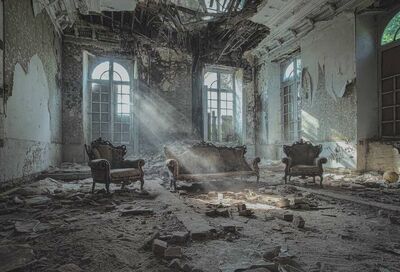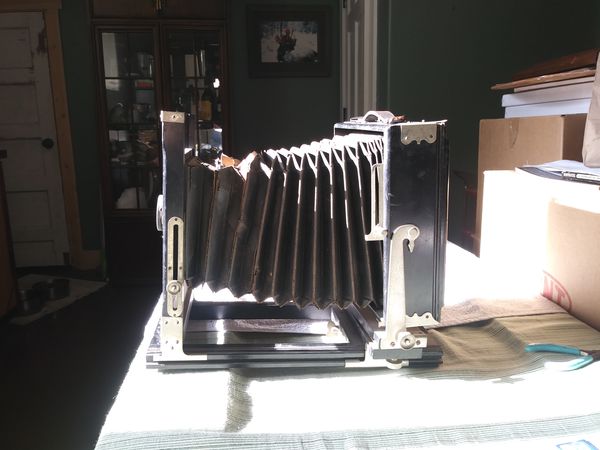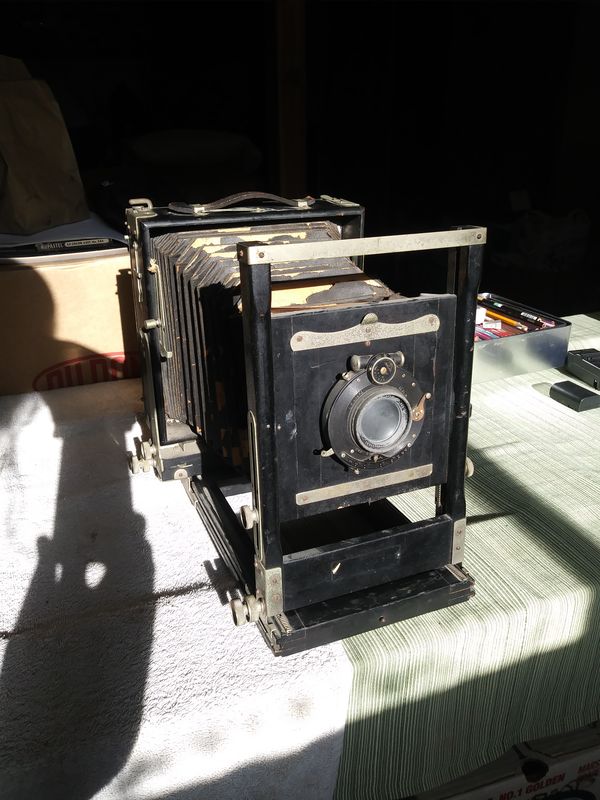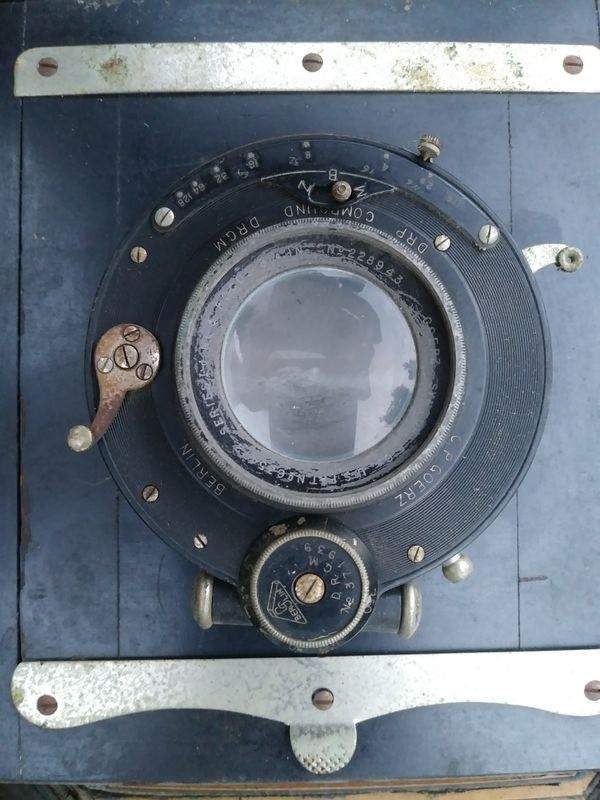requsting info on a camera and lens
Jul 28, 2019 11:11:02 #
Good morning everyone,
I was recently given this camera, and have been pursuing info mainly on the lens thus far.
Most of what i have learned come through early catalogs between 1911- 1916.
What i can read off of the lens itself:
Goerz syntor series 1, focus 8 1/4inch, f6.8, no. 228943, us patent no. 635472
Serial number on side of lens, no.137430
On the side of the box i found,
Patented Nov. 1906
Does anyone have exerience or knowledge of these types of cameras?
TYIA
David
I was recently given this camera, and have been pursuing info mainly on the lens thus far.
Most of what i have learned come through early catalogs between 1911- 1916.
What i can read off of the lens itself:
Goerz syntor series 1, focus 8 1/4inch, f6.8, no. 228943, us patent no. 635472
Serial number on side of lens, no.137430
On the side of the box i found,
Patented Nov. 1906
Does anyone have exerience or knowledge of these types of cameras?
TYIA
David
Jul 28, 2019 11:16:06 #
appreciate the journey wrote:
Good morning everyone, br I was recently given th... (show quote)
David, It is a view camera in very bad shape. The lens has fog on the front element and would need a cleaning, and the shutter mechanism would need a clean, lubrication and adjustment. Thb ellows would need replacement. In it's day it was a great lens (Goerz) Sp? good project?
Jul 28, 2019 11:24:55 #
davesit
Loc: Media, PA
I came across this company decades ago when I was doing some research on Zeiss-Ikon. Goerz was a German company founded in Berlin in the last century. It was a company specializing in optics and started making cameras as well. During WWI, the company made equipment for the German and Austria military. After WWI, it was forbidden to continue its military business and was about to go bankrupt, but was saved when it merged with three other companies to form Zeiss-Ikon. I believe they also formed a subsidiary in America before the turn of century (1900) and made lenses for various companies including Kodak. Goerz (Germany) made a series of cameras and Syntor was one of them.
Don't know much more other than from my sketching memory above. I would guess your camera is probably about 100 years old.
Don't know much more other than from my sketching memory above. I would guess your camera is probably about 100 years old.
Jul 28, 2019 18:44:54 #
Harry0
Loc: Gardena, Cal
I had a more "modern" one, the 54/2.
Finally gave it away @ 20 years ago to someone who might use it again.
If you're not screw driver illiterate, this is an easy project. Not a short, nor a long one.
Because this only takes 1 picture at a time, it needs to be right-
you'll gain much experience in the art of balancing aperture and shutter speed.
ISO will probably stay the same, depending on the film.
You'll need a meter; I did.
Good for many uses; best for landscapes. Long exposures are best.
Our buddy Ansel wrote some books.
Do NOT use as your only camera!
Finally gave it away @ 20 years ago to someone who might use it again.
If you're not screw driver illiterate, this is an easy project. Not a short, nor a long one.
Because this only takes 1 picture at a time, it needs to be right-
you'll gain much experience in the art of balancing aperture and shutter speed.
ISO will probably stay the same, depending on the film.
You'll need a meter; I did.
Good for many uses; best for landscapes. Long exposures are best.
Our buddy Ansel wrote some books.
Do NOT use as your only camera!
Jul 29, 2019 10:27:48 #
You are facing to a wonderful restoration project, David.
I own similar cameras although maybe not as old (?).
They are museum pieces I like to take care of and only sometimes I take them out to take pictures.
You will need even the simplest exposure meter.
The great news is, that your camera has the lens board and the back movements for perspective control - the modern digital cameras don't have.
The question is, what kind of sheet film or glass plate holders came with the camera? Sheet film (B&W or color) is available even today. If the sheet film holders have a different size, you can resize larger sheet film in the darkroom individually.
Look for holes in the bellows. In some cases the holes could be patched up. A complete replacement of the bellows is usually costly.
The tripod thread might have a larger size, but there are adapters avaliable.
Modern lenses (150mm or 210mm with shutters) and the lensboards for your camera are also available.
Camera cleaning is a simple procedure you can do yourself.
Happy shooting!
I own similar cameras although maybe not as old (?).
They are museum pieces I like to take care of and only sometimes I take them out to take pictures.
You will need even the simplest exposure meter.
The great news is, that your camera has the lens board and the back movements for perspective control - the modern digital cameras don't have.
The question is, what kind of sheet film or glass plate holders came with the camera? Sheet film (B&W or color) is available even today. If the sheet film holders have a different size, you can resize larger sheet film in the darkroom individually.
Look for holes in the bellows. In some cases the holes could be patched up. A complete replacement of the bellows is usually costly.
The tripod thread might have a larger size, but there are adapters avaliable.
Modern lenses (150mm or 210mm with shutters) and the lensboards for your camera are also available.
Camera cleaning is a simple procedure you can do yourself.
Happy shooting!
Jul 29, 2019 12:26:04 #
It's definitely not a camera for quick shooting. I was extremely fortunate to be taught to use a view camera by AA himself. Part of the Adam's previsualization includes exposing a single sheet of film at a time so that every negative can be given optimal development. If you are into darkroom work and film (I definitely am) there is nothing quite like the satisfaction you get using a view camera (swings, tilts, etc.) to make an photo with the exposure and perspective you visualize, developing the negative, and using the big negative to make the print you visualized before you released the shutter. Without getting into a limited number of expensive lenses (there are some available with limited perspective control), you can't even approach the level of focus and perspective control offered by a view camera using a camera with fixed lens mount. It would be a relatively easy matter to upgrade that camera to more modern lenses and shutters if you wanted to make the inve$tment.
Jul 29, 2019 13:01:21 #
amfoto1
Loc: San Jose, Calif. USA
That's a neat old camera!
The lens and shutter assembly information seems to be pretty well sorted out. The camera itself is more of a mystery. And that might never be solved. From the late 1800s through 1938 there were many different small manufacturers of cameras like that,. In fact, many "name brand" cameras were outsourced from small shops and showed a lot of variation. This was especially true of the larger format cameras such as this one.
That appears to be a "studio" model... because it doesn't appear to be able to fold up the way "field" cameras could. The tall front lens standards with the metal brace across them and the long bottom lens board look like the camera was never intended to be foldable. But those also could be modifications that were done to the camera at some time in the past.
It does appear to have rise, fall and tilt movements on the front standards/lens board.... but little to no swing movements. The rear/film plane looks like it might have some modest swings, and I'd expect it to have tilt movements.... but no rise and fall.
It will be difficult to get that camera into working condition. The bellows appear to be in pretty rough shape. Those can be repaired or replaced, but it won't be easy or cheap. The shutter mechanism and lens also look like they need serious work.
You didn't show us the back of the camera, but many from that time period used glass plates rather than film.... and often in odd sizes such as "half plate" or "quarter plate".
An 8.25" lens is equivalent to about 205mm focal length. That's roughly what I'd expect for a "standard" lens on a half plate camera.... so I assume that's the format of this camera: using film or plate that measures about 4.25x5.5 inches or 11x14cm. (Film holders would be about half inch larger on all sides... or approx. 5.5x6.5" outside dimensions.)
If you want to shoot with this camera, it might be more practical to simply buy a more modern lens and shutter in working condition. It wouldn't be difficult to make a lens board to be able to fit that to the camera. (A more modern shutter also might have speed range that's more practical with modern film.) You could use a modern lens between 180mm and 210mm 250mm on that camera without much problem. I doubt it has sufficient bellows length for much longer (more telephoto) focal length.... maybe 250mm. I also imagine it's pretty limited how short (wide angle) a lens it can use.... maybe 150mm at the widest. This is probably equiv. to approx. 40mm on "full frame". 250mm is probably roughly equivalent to 70mm on "full frame". (These are guesstimates, since we don't know for certain the format of the camera.)
I assume there's a ground glass focusing screen on the rear of the camera (if not, they can be replaced). Once the camera has been focused, the ground glass is either removed swung out of the way, replaced by the film holder. Some cameras, especially later and more modern ones, the ground glass is spring loaded and a film holder simply slides into place in order to make the image.
Some cameras had built-in, folding shades on the back for the ground glass, to help with focusing the dim image seen there. Others used a "dark cloth" that you draped over yourself and the camera (I made my own dark cloth... white vinyl on the outside, black cloth on the inside.... waterproof... and with lead-weighted corners to keep it from flapping in the wind.)
Because you are directly viewing what the lens is projecting onto it, the image you see on the ground glass will be upside down and reversed. (The pentaprism in SLRs and DSLRs corrects this. Mirrorless cameras flip the image they show you, too.)
If the camera doesn't have any matched film holders with it, you might be able to find some that fit. But the most critical dimension is that the film (or glass plate) be positioned precisely the same as the ground glass, so that the focused image is presented to the film exactly the same as it was seen on the focusing screen.
Early sheet films were similar to glass plate sizes. Both used film holders with somewhat larger dimensions. But there were a number of different types of those holders, too. Unless you want to make your own glass plates, you'd have to find some film holders that fit the camera and also can accommodate modern film sizes. This might be tricky! Most holders accommodate two sheets of film. So you'd need a small stack of them if you want to make multiple shots.
The film holders need to be loaded in complete darkness. And, after it's been exposed, you may have trouble getting sheet film developed. Might have to set up to do it yourself. (In which case, black & white film processing isn't difficult.... color is.) Once the film is developed, making any prints larger than direct contact (i.e., the same size as the film neg itself), will require a fairly big enlarger setup. (The good news is that enlargers, enlarging lenses and other darkroom equip. can be found pretty cheap on the used market.)
Using a camera such as this really forces you to slow down and think about each and every shot. You also can really dial in each shot, using techniques like the Zone System to individual develop every single shot to perfection. When I was working with my Wista 4x5 field camera, I used a 1 degree spot meter to calculate exposure and dynamic range, then developed the film accordingly (adjusting time and temp to perfectly match the dynamic range of the scene to the film's capabilities). I carried 10 film holders for short outings (a total of 20 shots) and on longer trips would take between 30 and 50 film holders, preloaded with B&W film. I used an Omega 4x5 enlarger to make prints up to 16x20". I experimented with color film and prints at one time... but ultimately found it too difficult to do very well without more rigid temperature control than was possible in my darkroom-on-a-budget. So when I wanted color I shot with transparency film, had it developed by a lab, and had them make prints from those if needed. Today I'd scan the transparencies and work with the images digitally... but I'd still have to outsource any large format color film development.
I also have a Polaroid film holder for my 4x5 camera. That was handy to do test shots and get quick feedback while setting things up. There used to even be a type of Polaroid film that produced both a negative and a positive. I don't know if any film is still being made for that holder though. And I doubt there would be anything to fit a camera the age of yours, without some modification of either the camera or the film holder.
Again, that's a cool old camera! If nothing else, it will make a neat display piece. Or, with some work, it might be made usable and fun to shoot with. Enjoy!
The lens and shutter assembly information seems to be pretty well sorted out. The camera itself is more of a mystery. And that might never be solved. From the late 1800s through 1938 there were many different small manufacturers of cameras like that,. In fact, many "name brand" cameras were outsourced from small shops and showed a lot of variation. This was especially true of the larger format cameras such as this one.
That appears to be a "studio" model... because it doesn't appear to be able to fold up the way "field" cameras could. The tall front lens standards with the metal brace across them and the long bottom lens board look like the camera was never intended to be foldable. But those also could be modifications that were done to the camera at some time in the past.
It does appear to have rise, fall and tilt movements on the front standards/lens board.... but little to no swing movements. The rear/film plane looks like it might have some modest swings, and I'd expect it to have tilt movements.... but no rise and fall.
It will be difficult to get that camera into working condition. The bellows appear to be in pretty rough shape. Those can be repaired or replaced, but it won't be easy or cheap. The shutter mechanism and lens also look like they need serious work.
You didn't show us the back of the camera, but many from that time period used glass plates rather than film.... and often in odd sizes such as "half plate" or "quarter plate".
An 8.25" lens is equivalent to about 205mm focal length. That's roughly what I'd expect for a "standard" lens on a half plate camera.... so I assume that's the format of this camera: using film or plate that measures about 4.25x5.5 inches or 11x14cm. (Film holders would be about half inch larger on all sides... or approx. 5.5x6.5" outside dimensions.)
If you want to shoot with this camera, it might be more practical to simply buy a more modern lens and shutter in working condition. It wouldn't be difficult to make a lens board to be able to fit that to the camera. (A more modern shutter also might have speed range that's more practical with modern film.) You could use a modern lens between 180mm and 210mm 250mm on that camera without much problem. I doubt it has sufficient bellows length for much longer (more telephoto) focal length.... maybe 250mm. I also imagine it's pretty limited how short (wide angle) a lens it can use.... maybe 150mm at the widest. This is probably equiv. to approx. 40mm on "full frame". 250mm is probably roughly equivalent to 70mm on "full frame". (These are guesstimates, since we don't know for certain the format of the camera.)
I assume there's a ground glass focusing screen on the rear of the camera (if not, they can be replaced). Once the camera has been focused, the ground glass is either removed swung out of the way, replaced by the film holder. Some cameras, especially later and more modern ones, the ground glass is spring loaded and a film holder simply slides into place in order to make the image.
Some cameras had built-in, folding shades on the back for the ground glass, to help with focusing the dim image seen there. Others used a "dark cloth" that you draped over yourself and the camera (I made my own dark cloth... white vinyl on the outside, black cloth on the inside.... waterproof... and with lead-weighted corners to keep it from flapping in the wind.)
Because you are directly viewing what the lens is projecting onto it, the image you see on the ground glass will be upside down and reversed. (The pentaprism in SLRs and DSLRs corrects this. Mirrorless cameras flip the image they show you, too.)
If the camera doesn't have any matched film holders with it, you might be able to find some that fit. But the most critical dimension is that the film (or glass plate) be positioned precisely the same as the ground glass, so that the focused image is presented to the film exactly the same as it was seen on the focusing screen.
Early sheet films were similar to glass plate sizes. Both used film holders with somewhat larger dimensions. But there were a number of different types of those holders, too. Unless you want to make your own glass plates, you'd have to find some film holders that fit the camera and also can accommodate modern film sizes. This might be tricky! Most holders accommodate two sheets of film. So you'd need a small stack of them if you want to make multiple shots.
The film holders need to be loaded in complete darkness. And, after it's been exposed, you may have trouble getting sheet film developed. Might have to set up to do it yourself. (In which case, black & white film processing isn't difficult.... color is.) Once the film is developed, making any prints larger than direct contact (i.e., the same size as the film neg itself), will require a fairly big enlarger setup. (The good news is that enlargers, enlarging lenses and other darkroom equip. can be found pretty cheap on the used market.)
Using a camera such as this really forces you to slow down and think about each and every shot. You also can really dial in each shot, using techniques like the Zone System to individual develop every single shot to perfection. When I was working with my Wista 4x5 field camera, I used a 1 degree spot meter to calculate exposure and dynamic range, then developed the film accordingly (adjusting time and temp to perfectly match the dynamic range of the scene to the film's capabilities). I carried 10 film holders for short outings (a total of 20 shots) and on longer trips would take between 30 and 50 film holders, preloaded with B&W film. I used an Omega 4x5 enlarger to make prints up to 16x20". I experimented with color film and prints at one time... but ultimately found it too difficult to do very well without more rigid temperature control than was possible in my darkroom-on-a-budget. So when I wanted color I shot with transparency film, had it developed by a lab, and had them make prints from those if needed. Today I'd scan the transparencies and work with the images digitally... but I'd still have to outsource any large format color film development.
I also have a Polaroid film holder for my 4x5 camera. That was handy to do test shots and get quick feedback while setting things up. There used to even be a type of Polaroid film that produced both a negative and a positive. I don't know if any film is still being made for that holder though. And I doubt there would be anything to fit a camera the age of yours, without some modification of either the camera or the film holder.
Again, that's a cool old camera! If nothing else, it will make a neat display piece. Or, with some work, it might be made usable and fun to shoot with. Enjoy!
Jul 29, 2019 14:31:19 #
amfoto1: Good post. As I am sure you know, 4 x 5 film is still available. However half-plate size would require cutting down from 8 x 10 ($$$). The Polaroid Type 55 P/N was what AA used in teaching the zone system and for a lot of his own, more recent, work. The back seat of his old Cadillac had stains where the tank of solution he had to put the negatives in to stabilize them splashed while he drove. I also have Polaroid backs for pack film (for both my view camera and Hasselblad) and have marked the ground glass of my view camera for the exposure area. Unfortunately, neither of those materials is currently being manufactured. Film for some of the most recent Polaroid type cameras is still available (Freestyle, etc.). Maybe someone will eventually take pity on us and start production of the larger sizes again.
At Brooks Institute, I learned that using Polaroid film to do a test shot was known as "pulling a roid".
At Brooks Institute, I learned that using Polaroid film to do a test shot was known as "pulling a roid".
Jul 29, 2019 18:53:43 #
appreciate the journey wrote:
Good morning everyone, br I was recently given th... (show quote)
You have what may be a 5x7 view camera. The 8 1/4 inch lens would be a normal lens for that size film. Measure the rear image size to be sure, it may be a full plate
(6 1/2 x 8 1/2) size.
Jul 31, 2019 15:25:16 #
OldBobD
Loc: Ohio
I see that the aperature settings are in the US stops, rather than f stops. In the US system each stop, like f stops, are 1/2 or 2x the one adjascent. However the numbering order is in the same increments: 4, 8, 16, 32, 64, 128. If my memory serves me correctly f16 and US16 are equivalent. therefore US4 would be equivalent to f8, US8 = f11, US64 = f22, etc.
If you want to reply, then register here. Registration is free and your account is created instantly, so you can post right away.







